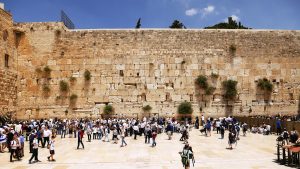The Psalmist’s oath: “If I forget thee, O Jerusalem, let my right hand forget her cunning” (Psalm 137:5).
Jerusalem, resting in the Judean Hills, was established 3000 years ago by King David as the capital of the Jewish nation. Jerusalem is the modern capital of the State of Israel, but not internationally recognized.
Jews have been living in Jerusalem continuously for nearly two millennia. They have constituted the largest single group of inhabitants there since the 1840’s. Today, the total population of Jerusalem is approximately 758.300, whereof 530.400 Jewish, 204.100 Arabs and 14.700 Christians.
Modern Jerusalem is divided in two parts: West Jerusalem, which has been part of the state of Israel since the country’s establishment in 1948, and East Jerusalem, which belonged to Jordan from 1948 to 1967, when it was formally annexed by Israel.
West Jerusalem is including much of the Jewish part of the city, which includes the modern centre of the city, and it is in many ways a tribute to the economic growth and prosperity Israel has enjoyed since its foundation and is characterized by leafy suburbs (Mishkenot Sha’ananim, Mea She’arim, Mahaneh Yehuda, etc), smart cafes and outgoing nightlife.
East Jerusalem, by contrast, offers very different charms. Mostly Arab, it has its own more relaxed pace of life, and street markets instead of shopping malls.
Most of Jerusalem’s main sights are found in Old Jerusalem, into this small area of land, less than one square kilometer (200 acres), is crammed a labyrinth of streets enclosed within walls of limestone dating back to the 16th century and the reign of the Ottoman ruler Suleiman the Magnificent.
The Old City is divided into quarters, named after the four communities that inhabited it during the Middle Ages: Arab, Jewish, Christian and Armenian.
No wonder Jerusalem has such a tremendous impact, both locally and internationally. To Jews, Jerusalem has always been “The Holy City”. The Wailing Wall at the foot of Temple Mount is all that remains of Jerusalem’s second temple and is Judaism’s most important place of prayer.
For Christians, the Church of the Holy Sepulcher is thought to contain the tomb where Jesus was laid to rest after the Crucifixion, having carried the cross through the city along the Via Dolorosa.
The Dome of the Rock on Temple Mount is Islam’s third most important religious site (after Mecca and Medina), and it is from here that Muhammad is believed to have ascended to heaven.
Jerusalem provides a unique opportunity to experience the contrasting opposites of ancient and modern, oriental and western, heavenly and earthly.
